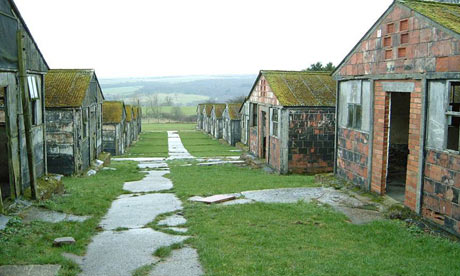Much is written about Allied prisoners of war held in Germany and Nazi-occupied countries during World War Two. But little is discussed about the German prisoners of war held in Britain or other Allied countries during the war.
Over half a million Italian and German soldiers were shipped back to Britain to the prisoner of war camps, where they spent the rest of the war locked up in re-purposed stately homes, converted army barracks or makeshift huts, which were often put together by the prisoners themselves.
In total there were around 1,500 prisoner of war camps and today, most of them have been abandoned and left to disarray. Two examples are the Hayes in Derbyshire and Eden Camp in North Yorkshire.
The Hayes, in Derbyshire, was built in the mid-1800s and held hundreds of prisoners during the war. It was also the location of one of the most infamous German attempts at escape.
Franz von Werra was a German fighter pilot and with a small team he dug his way out under the prison’s perimeter fence. Franz pretended to be a Dutch pilot and commandeered a British Hurricane aircraft before attempting to fly back to Germany. Lucky for the Allies, his imminent escape was discovered just before he was due to take off.
After the war, the Hayes became a Christian Conference Centre and remains so today. The tunnel’s entrance used by the escapees was only discovered in 1980 behind an old fireplace.
The story of the escape was made famous by the 1957 movie ‘The One That Got Away’.
Eden Camp, in North Yorkshire, is one of the best original examples of a World War Two prison and has been converted into a war museum.
The camp opened in 1942, and many of the inmates integrated into the local community. They took up farm work, forming musical bands and holding dances and events in the town.
Prison life at Eden was said to be quite pleasant, with the Italians becoming highly popular with the local ladies and Germans focusing more on working hard, the BBC News reports.
Eden has 34 of its huts and around 160,000 visitors come to the museum every year. It is said to be one of only around 12 prisoner of war sites in the UK that still look as they did during the war.
After the war, Eden Camp was used for housing and was then converted into a storage site in the 1950s. It was a group of former Italian inmates at the prison which gave the owner the idea of converting the site into a museum during the 1980s.
Other prisoner of war camps around the UK include Camp 21 at Cultybraggan, Perthshire; Camp 90 at Friday Bridge, Cambridgeshire; and Camp 93 at Harperley, County Durham.
